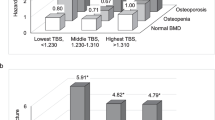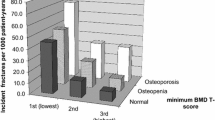Abstract
Several cross-sectional studies have shown the ability of the TBS to discriminate between those with and without fractures in European populations. The aim of this study was to assess the ability of TBS to discriminate between those with and without fractures in a large female Caucasian population in the USA. This was a case–control study of 2,165 Caucasian American women aged 40 and older. Patients with illness or taking medications known to affect bone metabolism were excluded. Those in the fracture group (n = 289) had at least one low-energy fracture. BMD was measured at L1–L4, TBS calculated directly from the same DXA image. Descriptive statistics and inferential tests for difference were used. Univariate and multivariate logistic regression models were created to investigate possible association between independent variables and the status of fracture. Odds ratios per standard deviation decrease (OR) and areas under the ROC curve were calculated for discriminating parameters. Weak correlations were observed between TBS and BMD and between TBS and BMI (r = 0.33 and −0.17, respectively, p < 0.01). Mean age, weight, BMD and TBS were significantly different between control and fracture groups (all p ≤ 0.05), whereas no difference was noted for BMI or height. After adjusting for age, weight, BMD, smoking, and maternal and family history of fracture, TBS (but not BMD) remained a significant predictor of fracture: OR 1.28[1.13–1.46] even after adjustment. In a US female population, TBS again was able to discriminate between those with and those without fractures, even after adjusting for other clinical risk factors.

Similar content being viewed by others
References
Ensrud KE, Lui LY (2007) Renal function and risk of hip and vertebral fractures in older women. Arch Intern Med 167(2):133–139
Bachetta J, Boutroy S et al (2010) Early impairment of trabecular microarchitecture assessed with HR-pQTC in patients with stage II–IV chronic kidney disease. J Bone Miner Res 25(4):849–857
Nickolas TL, Leonard MB, Shane E (2008) Chronic kidney disease and bone fracture: a growing concern. Kidney Int 74:721–731
Moe S, Drueke T, Cunningham J et al (2006) Definition, evaluation, and classification of renal osteodystrophy: a position statement from Kidney Disease: Improving Global Outcomes (KDIGO). Kidney Int 69:1945–1953
Johnell O, Kanis JA (2006) An estimate of the worldwide prevalence and disability associated with osteoporotic fractures. Osteoporos Int 17(12):1726–1733
WHO Study Group (1994) Assessment of fracture risk and its application to screening for postmenopausal osteoporosis. Report of a WHO study group. World Health Organ Tech Rep Ser 843:1–129
Hordon LD, Raisi M, Paxton S, Beneton MM, Kanis JA, Aaron JE (2000) Trabecular architecture in women and men of similar bone mass with and without vertebral fracture: Part I. 2-D histology. Bone 27(2):271–276
Johnell O, Kanis JA, Oden E, Johansson H, De Laet C, Delmas P et al (2005) Predictive value of BMD for hip and other fractures. J Bone Miner Res 20(7):1185–1194
Link TM, Majumdar S (2004) Current diagnostic techniques in the evaluation of bone architecture. Curr Osteoporos Rep 2(2):47–52
Rubin CD (2005) Emerging concepts in osteoporosis and bone strength. Curr Med Res Opin 21(7):1049–1056
Pothuaud L, Barthe N, Krieg M-A, Mehsen N, Carceller P, Hans D (2009) Evaluation of the potential use of trabecular bone score to complement bone mineral density in the diagnosis of osteoporosis: a preliminary spine BMD-matched, case-control study. J Clin Densitom 12(2):170–176
Rabier B, Héraud A, Grand-Lenoir C, Winzenrieth R, Hans D (2010) A multicentre, retrospective case-control study assessing the role of trabecular bone score (TBS) in menopausal Caucasian women with low areal bone mineral density (BMDa): analysing the odds of vertebral fracture. Bone 46(1):176–181
Winzenrieth R, Dufour R, Pothuaud L, Hans D (2010) A retrospective case-control study assessing the role of trabecular bone score in postmenopausal Caucasian women with osteopenia: analyzing the odds of vertebral fracture. Calcif Tissue Int 86(2):104–109
Del Rio LM, Winzenrieth R, Cormier C, Di Gregorio S (2013) Is bone microarchitecture status of the lumbar spine assessed by TBS related to femoral neck fracture? a Spanish case-control study. Osteoporos Int 24(3):991–998
Leib E, Winzenrieth R, Aubry-Rozier B, Hans D (2014) Vertebral microarchitecture and fragility fracture in men: a TBS study. Bone 62:51–55
Colson F, Winzenrieth R (2011) Assessment of osteopenic women microarchitecture with and without osteoporotic fracture by TBS on a new generation bone densitometer. ISCD annual meeting, Miami, USA
Vasic J, Petranova T, Povoroznyuk V, Barbu CG, Karadzic M, Gojkovic F, Elez J, Winzenrieth R, Hans D, Culaficvojinovic V, Poiana C, Dzerovych N, Rashkov R, Dimic A (2013) Evaluating spine micro-architectural texture (via TBS) discriminates major osteoporotic fractures from controls both as well as and independent of site matched BMD: the Eastern European TBS study. J Bone Miner Metab. doi:10.1007/s00774-013-0529-7
Lamy O, Metzger M, Krieg MA, Aubry-Rozier B, Stoll D, Hans D (2011) OsteoLaus: prediction of osteoporotic fractures by clinical risk factors and DXA, IVA and TBS]. Rev Med Suisse 7(315):2130, 2132–4, 2136. French. PMID: 22187782
Krueger D, Fidler E, Libber J, Aubry-Rozier B, Hans D, Binkley N (2014) Spine trabecular bone score (TBS) subsequent to BMD improves fracture discrimination in women. JCD 17(1):60–65
Hans D, Goertzen AL, Krieg MA, Leslie WD (2011) Bone micro-architecture assessed by TBS predicts osteoporotic fractures independent of bone density: the Manitoba study. J Bone Miner Res 26(11):2762–2769
Boutroy S, Hans D, Sornay-Rendu E, Vilayphiou N, Winzenrieth R, Chapurlat R (2013) Trabecular bone score helps classifying women at risk of fracture: a prospective analysis within the OFELY study. Osteoporos Int 24(1):77–85 Epub 2012 Oct 16
Popp AW, Meer S, Krieg M-A, Perrelet R, Hans D, Lippuner K (2012) BMD combined with microarchitecture parameters (TBS) significantly improves the identification of women at high risk of fracture: the SEMOF cohort study. In: IOF-ECCEO, 2nd European congress on osteoporosis and osteoarthritis, Bordeaux, France, 21–24 March
Iki M, Tamaki J, Sato Y, Kadowaki E, Dongmei N, Winzenrieth R, Kagamimori S, Kagawa Y, Yoneshima H (2014) Trabecular bone score predicts vertebral fracture over 10 years independently of bone density in Japanese women: the Japanese population-based osteoporosis (JPOS) cohort study. JBMR 29(2):399–407
Krieg MA, Aubry-Rozier B, Hans D, Leslie WD; Manitoba Bone Density Program (2013) Effects of anti-resorptive agents on trabecular bone score (TBS) in older women. Osteoporos Int 24(3):1073–1078
Popp AW, Guler S, Lamy O, Senn C, Buffat H, Perrelet R, Hans D, Lippuner K (2013) Effects of zoledronate versus placebo on spine bone mineral density and microarchitecture assessed by the trabecular bone score in postmenopausal women with osteoporosis: a three-year study. J Bone Miner Res 28(3):449–454
Hans D, Krieg MA, Lamy O, Felsenberg D (2012) Beneficial effects of strontium ranelate compared to alendronate on trabecular bone score in post menopausal osteoporotic women. A 2-year study. In: IOF-ECCEO, 2nd European congress on osteoporosis and osteoarthritis, Bordeaux, France, 21–24 March
Günther B, Popp AW, Stoll D (2012) Beneficial effect of PTH on spine BMD and microarchitecture (TBS) parameters in postmenopausal women with osteoporosis. A 2-year study. Osteoporosis Int 23(Suppl. 2):S85–S386
McClung MR, Lippuner K, Brandi ML, Kaufman J-M, Zanchetta J, Krieg MA, Bone HG, Chapurlat R, Hans D, Wang A, Yun J, Zapalowski C, Libanati C (2012) Denosumab significantly improved trabecular bone score (TBS), an index of trabecular microarchitecture, in postmenopausal women with osteoporosis. In: ASBMR, Minneapolis, MN, 12–16 October
Eller-Vainicher C, Morelli V, Ulivieri FM, Palmieri S, Zhukouskaya VV, Cairoli E, Pino R, Naccarato A, Scillitani A, Beck-Peccoz P, Chiodini I (2012) Bone quality, as measured by trabecular bone score in patients with adrenal incidentalomas with and without subclinical hypercortisolism. J Bone Miner Res 27(10):2223–2230
Romagnoli E, Cipriani C, Nofroni I, Castro C, Angelozzi M, Scarpiello A, Pepe J, Diacinti D, Piemonte S, Carnevale V, Minisola S (2013) “Trabecular bone score” (TBS): an indirect measure of bone micro-architecture in postmenopausal patients with primary hyperparathyroidism. Bone 53(1):154–159
Leslie WD, Aubry-Rozier B, Lamy O, Hans D (2013) TBS (trabecular bone score) and diabetes-related fracture risk. JCEM 98(2):602–609
Winzenrieth R, Michelet F, Hans D (2013) Three-dimensional (3D) microarchitecture correlations with 2D projection image gray-level variations assessed by trabecular bone score using high-resolution computed tomographic acquisitions: effects of resolution and noise. J Clin Densitom 16(3):287–296
Hans D, Barthe N, Boutroy S, Pothuaud L, Winzenrieth R, Krieg M-A (2011) Correlations between TBS, measured using antero-posterior DXA acquisition, and 3D parameters of bone micro-architecture: an experimental study on human cadavre vertebrae. J Clin Densitom 14(3):302–311
Court-Brown CM, Clement ND, Duckworth AD, Aitken S, Biant LC, McQueen MM (2014) The spectrum of fractures in the elderly. Bone Joint J 96-B(3):366–372
Melton LJ 3rd, Crowson CS, O’Fallon WM (1999) Fracture incidence in Olmsted County, Minnesota: comparison of urban with rural rates and changes in urban rates over time. Osteoporos Int 9(1):29–37
Siggeirsdottir K, Aspelund T, Jonsson BY, Mogensen B, Gudmundsson EF, Gudnason V, Sigurdsson G (2014) Epidemiology of fractures in Iceland and secular trends in major osteoporotic fractures 1989–2008. Osteoporos Int 25(1):211–219
van Staa TP, Dennison EM, Leufkens HG, Cooper C (2001) Epidemiology of fractures in England and Wales. Bone 29(6):517–522
Ray NF, Chan JK, Thamer M, Melton LJ 3rd (1997) Medical expenditures for the treatment of osteoporotic fractures in the United States in 1995: report from the National Osteoporosis Foundation. J Bone Miner Res 12(1):24–35
Delmas PD, Marin F, Marcus R, Misurski DA, Mitlak BH (2007) Beyond hip: importance of other nonspinal fractures. Am J Med 120(5):381–387
Acknowledgements
We acknowledge the efforts by Augusta Wilson, Brenda Leible and Brenda Mullen for helping with review of records for fracture location identification.
Human and Animal Rights and Informed Consent
This study was conducted in accordance with the current version of the declaration of Helsinki and under the laws and regulations enforced by the Department of Health. Each subject enrolled into the study was ensured anonymity.
Author information
Authors and Affiliations
Corresponding author
Additional information
E. Leib and O. Lamy have no conflict of interest; R. Winzenrieth is Senior scientist for Med-Imaps; D. Hans is CEO of Med-imaps and ownership shares.
Rights and permissions
About this article
Cite this article
Leib, E., Winzenrieth, R., Lamy, O. et al. Comparing Bone Microarchitecture by Trabecular Bone Score (TBS) in Caucasian American Women with and Without Osteoporotic Fractures. Calcif Tissue Int 95, 201–208 (2014). https://doi.org/10.1007/s00223-014-9882-3
Received:
Accepted:
Published:
Issue Date:
DOI: https://doi.org/10.1007/s00223-014-9882-3




